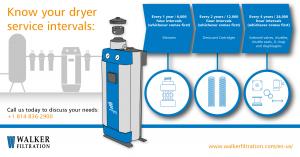The Importance of Servicing Your Regenerative Compressed Air Dryer
The ultimate guide to servicing your compressed air dryer
Posted on May 25th, 2021
Skipping a dryer service interval, like cutting out an oil change on your car, can have a negative long-term impact on your system. This will end up costing you more money in the long run. Desiccant dryers require preventative maintenance to ensure peak operational efficiency.
So, you might ask, what are the potential risks of not carrying out regular dryer maintenance?
Poor Air Quality
If left un-serviced, a reduction in efficiency can lead to water being present downstream. This impacts the quality of the compressed air and the system’s health. Bad air quality could damage equipment and result in product spoilage, costly repairs, system downtime and even a danger to employees themselves.
Blocked Silencers
Desiccant dust in the purge airstream can gradually block the silencers, creating higher backpressure. Higher backpressure impacts internal valves, which can lead to them not sealing correctly. When internal valves stop working, your dryer will stop functioning correctly.
Decreasing the Desiccant Life Span
Even though desiccant is regenerated, it will lose its effectiveness and wear over time, which could cause desiccant dust to form. Desiccant dust causes the dryer to become less effective at removing moisture and can potentially lead to higher differential pressure, which causes a significant reduction in inefficiency. Additionally, the airstream can damage the operation of the internal components such as valves, seals and silencers.
Damaged Solenoid Valves, Shuttles, Shuttle Seats and O-rings
Parts such as solenoid valves, shuttles, and o-rings do eventually wear down and need to be replaced. Although these parts have a longer service life than dryer silencers and desiccants, failure to replace them at the recommended intervals can run the risk of seals failing, causing product failure. This can impact your whole system, the end application, and leave you with substantial costs.
For example, the longer your dryer must run, the more energy that is used. When using dewpoint management control at a -40˚F (-40˚C) dewpoint, the dryer will have to run for a longer period before reaching the set dewpoint. Only when it hits the dewpoint will the dryer isolate the purge. The longer your dryer works to regenerate the desiccant and maintain dewpoint, the more energy it uses, and the more your operating costs will increase.
Know your dryer service intervals:
